Introduction
Transferring knowledge to the next generations is a basic principle of humanity, moreover a way to make an organization more successful. Nowadays organizations are using different ways to become more competitive, to increase not only productivity but also the job satisfaction of the young and older generation. One proven way is to use the knowledge and experience of the older generation. With their parental charism they transmit not only the confidence to young employees, moreover useful knowledge, their experience and know-how. This situation is beneficial for both parties, and the organization also benefit from higher productivity, higher job satisfaction and higher loyalty of young employees. This creates a work environment enriched of an empathic and ethically valuable relationship (Backes-Gellner and Veen, 2019). An essential precondition for companies’ high productivity is employees’ high performance while companies need to care for employees’ welfare, job satisfaction, personal development and promotion. They strive to meet the requirements of career development of their employees and to uncover employees’ talents through talent management. One way to achieve is to harness the knowledge and experience of the older generation, a big and complex challenge for the whole business world. Such approaches are one of the most important conditions to face the changing times and competition. Companies challenge is to create harmonious work teams of different generations with different preferences and views and target for high participants’ job satisfaction to achieve best cognitive efforts and productivity (Vasconcelos, 2018). The demographic change with shrinking qualified personnel let baby boomers gaining great value and appreciation in Human Resource Management because of their great experience, knowledge, and special employees’ skills (Hübner, Kühl and Putzing, 2003). The main goal of this work is to provide data against the bias of older workers, adjust assumed misconceptions. The review outlined the theoretical framework and methodological considerations in terms of organizations and Human Resource Management with actual empirical findings according working teams of different ages. Subgoal is the analysis of the dependency between productivity increase and collaboration of different generations and pointing out the importance of reintegrating pensioners, today’s baby boomers, in organizations concerning newly hired and young employees, known as generation Z and Millennials. The efficiency of teams with and without retirees and the impact of collaboration on the personality and job satisfaction of young and older colleagues will be outlined.
Methods
The research fundamentally bases on literature review. The method of qualitative content analysis by Mayring and Fenzl (2019), an essential part of the literature analysis, was a supportive element to interpret the findings. The coding system MAXQDA developed by Kuckartz (2019) has been applied for achieving a structured analysis. Scientific methods as well synthesis, deduction and comparations were elements for the elaboration of the chosen topic intending to answer the following research question: ‘Is effective collaboration of different generations a tool for the success of the organizations?’ Performing extensive literature review and a qualitative literature analysis following databases/library catalogues have been analysed: Springer Link, SCOPUS, Research Gate, Google Scholar, Google Search, Wiley Online Library, Forbes, Harvard Business Review. Search terms as part of a targeted literature search have been created: reintegration of pensioners, performance efficiency of teams, impact on personality (on the Big Five factors), impact on job satisfaction, impact on productivity. Quantitative and qualitative data from scientific studies with cross-sectional, meta-analysis and longitudinal character have been collected and analysed. The main profession analysing field is Human Resource Management. Data included descriptive statistics and have been deductively analysed. Thereby tables, graphs and charts with nominal, ordinal and metric data of interviews and surveys have been collected and analysed. The surveys included employees and managers, aged 20 to 65 as probands. Elaboration of theoretical basics targeted on selected problems have been required for achieving the goals. All sources corresponding to the valid scientific requirement for the level of detail and quality of the elaboration have been classified as relevant. The literature research identified 55 potential sources, 46 were identified as relevant and attached as references. Relevant data were collected, categorised and analysed. Figure 1 shows the sequences of the process of structured content analysis related to the research question. The text work consisting of text review have been basis for the categories of the topic. Relevant sources have been analysed and classified into these categories by elaborating relation to each other.
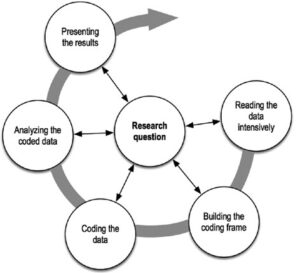
Figure 1: The five phases of qualitative content analysis
Source: Kuckartz (2019)
Applying MAXQDA one main code, reflecting the subject ‘’Aging workforce’’, has created to nine ‘’first-level subcodes’’, reflecting by the upper term the importance of the research field within the labour market. Two ‘’second-level subcodes’’ have contributed to the contrasting topics ‘’advantage of older workers, which led to the section ‘’collaboration advantages’’ and ‘’bias against collaboration’’ of two generations, which is enclosed by the section ‘’collaboration disadvantages.’’ Eight ‘’third-level-subcodes’’ have been emerged inductively and deductively. The present literature has been encoded by the method of structured content analysis. Thereby passages have been encoded in 1318 codings and subsequently analysed in relation to the research question. Synthesising all data, led to the following results and conclusion. Frequent individual studies and researches reflecting similar results could lead to an inductive relation with possible recommendations for companies against their bias. Overview of the created codes and subcodes, as well as their hierarchy, see Figure 2.
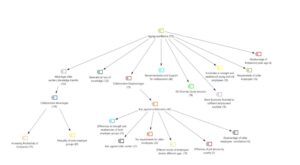
Figure 2: Hierarchical code-subcodes model by MAXQDA
Source: own depiction
Theoretical background
The topic ‘Effective collaboration of different generations as a tool for the success of the organizations bases on the existence of an ageing population longer staying at work that reshapes the labour market. Two key problems in terms of Human Resource Management are the rapid growth of companies that put pressure on the organization structure and culture (Srinivasan, 2012) and a lack of personnel caused by retired baby boomers. The need for collaboration of different generations is gaining momentum. The informal relationships in the organizations are under stress because of the need of hiring new employees. Informal groups of older workers, experienced and specialized on the early stages of the organization, are reaching their best form shortly before getting retired and if necessary, become reintegrated, while new young workers with higher qualification and skills need the experience to collaborate. Some companies and leaders are considering older workers not as potential workers covering their personal demand. They have still existing bias. Other companies are promoting teams of older and younger workers transferring skills and experience to each other and increasing companies’ success. Due to the massive acceleration of technological progress and digitization lifelong learning and training is compelling also for workers of older ages who will participate in work teams. Companies’ goal is to accomplish team effectiveness of each team. Success or failure of a team highly relies on the interaction level of all members. Effective teamwork is a latent learning outcome and the most desired skill required by employers (Wang, Zuo, and Bo, 2014). According to the research results of Mantoro et al. (2018) factors having significant impact on team effectiveness were identified. These factors are described as both, inherent human features related to personality and results of the leading force. Job satisfaction and performance are the most weighting moderators of team effectiveness. Trust as secondary moderator of team effectiveness belongs to the personality factor ‘’loyalty’’. According to the study of Oswald, Proto and Sgroi (2015) three different styles of an experiment randomly selected individuals who were made happier. These treated individuals indicated approximately 12% greater productivity. Comparing the generation X and the free genes, different work values can be determined. Free genes, born 1945–1960, are preferring work values like hard-working, reliability, loyalty and are considering work as inevitable. In contrast, the generation X, born 1980–1990, with work values like flexibility, high job satisfaction, duty based, work-life balance and are considering work as a challenge. The differences of these generations do not forcibly imply being incompatible for same work teams.
The importance of two-generation collaboration
Related to the topic ‘Effective collaboration of different generations as a tool for the success of the organizations’ a question entailed: ‘‘Why should employers hire older workers?’’ According to several scientists, companies benefit from older workers’ experience and skills they bring to job. An analysis by Maestas (2010), economist at Harvard Medical School, revealed that more than a quarter of retirees later resumed working. A more recent survey from RAND Corporation (2017) found almost 40% of workers aged over 65 had previously retired (Meastas et al., 2019). Meastas outlined that integration of older workers helps solving problems immediately. Academical jobs are the most attractive in Germany, counted 21,2%. Figure 3 demonstrates statistical data of the Federal Institute for Safety and Health Protection at Work published by Destatis Mikrozensus. They have recorded the proportion of employed people by age in Germany in 2017. Considering the total age groups related to their share of the working population, 58% of older employees are aged of 60-64. 55-59-aged employees counted 80%, 40-44-aged employees 86% and 30-34-aged employees counted 83% of the total German employee population. Demonstrating the trend of the past 20 years, the proportion of older workers is higher than young workers. Moreover, older workers got more importance for companies, size of the company is not considered.
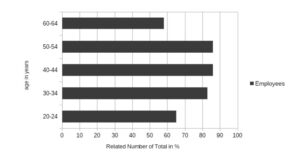
Figure 3: Employees by age in Germany 2017 (own depiction)
Source: Federal Institute for Occupational Safety and Health BAuA, Destatis Mikrozensus (2017)
Related to the research topic, results of Backes-Gellner and Veen (2013) confirmed that age diversity would lead to success and more productivity. According to the results of a large-scale employer-employee panel data set analysis with 41,815 observations within 12,448 groups, increasing age diversity has a positive effect on companies’ productivity if a company engages for creative rather than routine tasks. The scientists presented the regression results of fixed effect estimations with ‘company productivity’ as the dependent variable and the coefficient of variation as a proximation of the explanatory variable ‘age diversity’. Longitudinal observations within a period of maximum 10 years carried out that an increase in age diversity in creative companies is strongly positive correlated to productivity. The coefficient 0.289 means if age diversity in a company in a creative industry increases by 1%, company productivity increases by 0.289%. An 10% increase in age diversity (a percentage amount similar the maximum change in diversity over the 10-year observation period in sample) in creative companies let increase productivity by approximately 3.5% in a year. This significantly clarifies a higher increase compared to the aggregate productivity growth in Germany of around 1% per year. Concluding, age diversity with integrated older workers is a source for productivity growth of creative task-based companies. The higher the worker’s tenure the greater their knowledge within companies’ internal work patterns and the more precise the workflow is, emphasizing the high rated informal knowledge collected by older workers over a long period of time. Figure 4 delivers insight of learning types in job- and lifetime. In general, 66% of informal knowledge is part of total learning. Retirees fit into patterns of companies’ requirement because of having both, great informal (social-private environment) and formal (institutionalized) knowledge in contrast to young employees. Older workers can fill the personnel lack and serve as a big source of knowledge for younger employees. Other research results reflect that the quality and quantity of knowledge transfer depends on the relationship with colleagues (Baethge, 2003).
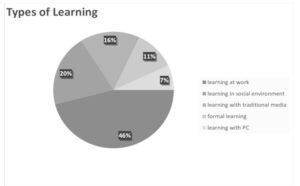
Figure 4: Distribution of the most important professional learning contexts (“most learned”)
(N = 3746; figures in%)
Source: Baethge, M. (2003), ‘Lifelong learning and work: further training competence and training behaviour of the German population’
Established literature under exploration test mode with 4 leaders and 7 pre-retirees in different industries through a face-to-face interview (Wang, Zuo and Bo, 2014) revealed factors affecting knowledge transfer between individuals. The factors are separated into the group of pre-retirees between 50 and 60 years and the group of young employees between 29 and 50 years. Categorised data results might be useful for companies creating beneficial work conditions for work teams of two different generations. Some observations are valuable for companies:
- Pre-retirees’ perceptions of younger employees have a positive effect on their intention of knowledge transfer. The more positive their perceptions are (young employees’ positive characteristics as active learning, good learning capacity, enterprising spirit), the stronger is the knowledge transfer intention of pre-retirees.
- If pre-retirees like the enterprise, they would like to transfer knowledge to the younger.
- If pre-retirees can get respect from younger people, they are pleased when younger employees make achievements with their help.
- Younger employee’s work attitudes are positively related to the pre-retiree’s intention of transferring knowledge; pre-retirees prefer to communicate with young and motivated employees having career ambition.
Attractive motivating principles building up teams with two different generations are pointed out by the research of Noethen (2011). She determined that more knowledge will be shared if the age difference between source and recipient is larger. A day-to-day knowledge share might constitute a feasible prevention strategy. If employees intend to leave, they share more knowledge, and if they expect to leave, they could involuntarily be encouraged by their supervisors to share their knowledge. According to the results of Foss et al. (2009), sharing knowledge depends on three categories of employee’s motivation. Three motivation types are relevant: 1. intrinsic, 2. introjecting and 3. external. Intrinsically motivated employees assess the activity itself interesting, enjoying and stimulating. Being introjectically motivated is concerned with maintaining and enhancing feelings of worthful in their social groups. Being externally motivated means that some external valued contingency drives his or her involvement in knowledge sharing. Intrinsic motivation has a very strong and positive influence on the transmission of knowledge, introjected motivation has a slightly weaker, yet positive effect. External motivation is rather negatively related to the extent of knowledge sent to colleagues. Older workers’ paternal behaviour and impetus transferring knowledge across generations is caused by their nature to be driven by intrinsic motivation sharing knowledge with a younger worker. Companies can use teams of different generations as a possibility to prevent knowledge and if they do not care about saving their knowledge, they generate a loss of knowledge very likely leading to a loss of their productivity. The demographic change with the shrinkage of qualified personnel, prevailing retiring baby boomers (Eckelt, 2014), was creating a remarkable problem of gapless recruiting employees. Reflecting the labour market conditions and older workers’ potential of being member of working teams, the age-different workforce will get more importance. Analysing article’s topic, we will become aware of the factors, relations, team and working structures enabling to resolve the bias against older workers, realising that the ageing workforce and multi-generational teams could be successful applying special leading recommendations.
Results and Discussion
Evaluating the performance efficiency of teams with and without retirees
Age diversity of working teams will become a successful trend. Table 1 presents an overview of different characteristics of different generations. Different times have shaped people differently and developed different features and characteristics. It could be assumed both, different generations are suitable to harmonize in job teams or they don’t. While generation Z is very professional in digital communication and technique, the generation of baby boomers are more likely unskilled in techniques and have demand to be trained. Baby boomers are considering work as an exciting adventure, the generation X is focusing work as a difficult challenge. While different individual features let recognise contrast they could be considered as supplement to each other if the individuals do not realise each other as a competitor and do not have bias against each other.
Table 1: Generational work values
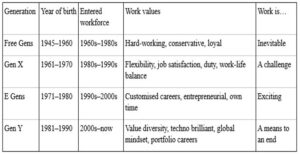
Source: Srinivasan, V. (2012), ‘ Multi generations in the workforce: Building collaboration’
Generating respectful teams age diversity could lead to success and productivity. A six-year research program by Wegge et al. (2012) analysed three different types of teams, administrative teams, financial service teams and teams of car production with nearly 523 teams. Main moderating and mediating variables regarding potential benefits related to age diversity were revealed. The results show that age diversity correlates positively with the performance of groups performing complex decision-making tasks. They proposed age-related deficits are reduceable by high task variety and possibly balanceable through selection, optimization and compensation strategies, prevailing conditions of complex task requirements without time pressure. Wegge et al. (2012) found a significant correlation (r = .13) between age diversity of financial consultant teams and team performance e.g., selling numerous different financial products to private and small enterprise customers have valuable demand of skills of complex and creative decision-making. Moreover, the benefits of team resources associated with higher age could be explained by organizational experience of older workers. Effective interventions promoting successful integration of older employees in workgroups are supporting conditions e.g., ergonomic design, issues, team composition and leadership processes in teams. As Srinivasan (2012) resumed, younger workers at their learning stage are more willing to learn new things and accept new ideas. They are not as flexible as older people with more life experience, mature and great problem-solving skills. As western findings suggested, Srinivasan (2012) realised the need of collaboration of older and younger employees to form a coherent and viable corporate culture. According to Gowrishankar, Kanagaraj and Gokula Krishnan (2017), 32% of employee performance caused by age diversity of the workforce in organizations. Organizations ensuring uniqueness of age diversity of the workforce have the potential to accomplish reduced conflicts, high utilization of the humans at work, possibly support the person-organization fit, person-job fit and person-group fit targeting for improving the performance of the employees in an organization (Gokula, Reeves and Renjitha, 2017).
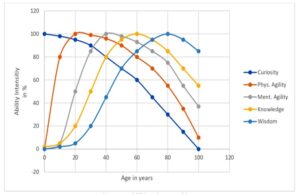
Figure 5: Abilities change with age
Source: Ventrella, J. (2019), ‘Aging, brain, intelligence, mind, youth’
The study on the ability development by age by Ventrella (2019) support the advantage of hiring older workers. People, aged of 60, are respectful employees, reaching the zenith of knowledge in contrast to employees aged of 30 who have nearly 50% of possible knowledge. Maximum of physical agility is being reached at age of 20-30, remarkable that physical agility of people, aged of 60, declines just by 20%. Older workers’ parental charisma does not create a climate of competition and inspire trust in young colleagues. Performance is more efficient in working teams of different ages established by the research results and longitudinal studies validating a significant positive correlation. Detailed and complex results of Gowrishankar, Kanagaraj and Gokula Krishnan (2017) and Wegge et al. (2012) underlined performance efficiency in age diverse teams. Applying supporting conditions e.g., ergonomic design, issues, team composition and leadership processes in teams, a successful integration of older employees in workgroups and a possible strategy of Human Resource Management, help increasing the performance efficiency of employees and productivity of companies.
Impact of reintegrated retirees on the personality of young colleagues
A team is made up of individuals improving the relationship of team members or causing trouble. Requirements of being a successful team depends on individuals’ potential of working together and being engaged. Personality creates individual behavior, triggers individual performance as well as productivity. Each personality has its own specifics, distinctive characteristics, and different level of knowledge. Each personality is not suited for every job position. Personal competences need to pair with duties to increase productivity and job satisfaction. Najam-us-Sahar (2015) confirmed personality factors as predictor for productivity, agreeableness as strongest predictor of salary. Emotional stability and proactive personality are predicting job success. Several studies pointed out the potential of the cooperation of different generations. Young workers can learn from older workers, benefit from their experience and help enriching their own personality (Schawbel, 2018). Reintegrated pensioners affect young worker’s personality, teaching younger workers how to resist struggles and setbacks, known as a burden in the process of building careers. Older convey younger workers handling with complex situations and provide them with soft skills help building relationships for reaching success. Older workers can motivate younger being loyal, thanks to which team members want to invest in their education and development (with the support of the organization). They can help younger workers improving their career, how to prevent same mistakes, how to manage corporate politics, especially of larger corporations. Older workers can train younger developing skills e.g., handling conflicts in the workplace and generating the creative wisdom using those conflicts to solve problems and form stronger relationships in the aftermath. These features are classified as extraversion, agreeableness, conscientiousness, emotional stability and openness, known as the ‘’Big Five Factors’’. The Big Five personality factors, an approach for the comprehensive description of human personality considered to be the most empirically proven personality traits (differential psychology). Central to this research approach is the so-called “lexical hypothesis”, which states that all important aspects of human personality are reflected in the trait words of a language. Several independent scientist groups defined the five factors based on empirical data. Ernest Tupes and Raymond Christal developed the initial model based on work at the American Air Force Personnel Laboratory in the late 1950s. J.M. Digman proposed his five-factor personality model in 1990 and Goldberg expanded it in 1993 to the highest level of a degree of organisation (Goldberg, 1993).
Table 2: Characteristics of generations of three clusters of age
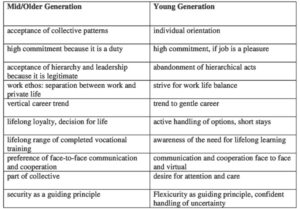
Source: Rump, J. and Eiler, S. (2015), ‘The interaction of the generations in the workplace’
Young workers also have an impact on older colleagues (Rump and Eiler, 2015) e.g, they can support older workers applying new technologies. Youngers can help older workers becoming more flexible, developing a wider perspective towards the changing world and job. Increasing abilities and expanding horizon enrich older worker’s tech-savvy and technically proficiency linked with flexibility. Younger workers can encourage older workers taking a risk and reduce their hierarchical thinking by extending their entrepreneurial mindset. They strive for balancing work and can slow older workers down for balancing their energy. They help older workers pursuing their dreams that are not yet realized. Munnel and Wu (2013) results show no evidence for older workers having adverse effects on young worker’s personality. Repressing youngers by older workers and disadvantage of building up collaboration teams of two generations were not confirmed. The previous dependencies are supportive fact that retirees are popular for companies to hire because of their life experiences and special expertise developed over a long period of time. Vasconselos (2018) figured out that older workers tend to display wiser characteristics and qualities necessary for helping younger workers and for improving organizations. Positive and consistent evidence of older workers’ capabilities related to creativity, innovation, quantitative and qualitative performance, soft skills, resilience, emotion regulation, engagement, motivation, job performance, job attitudes, training motivation, solving problems, social skills, and motivation to develop themselves continuously was exhibited. Moreover, Peeters and van Emmerik (2008) revealed that older workers have great potential to create value for organizations and numerous positive organizational outcomes such as increased employee loyalty, decreased employee turnover, retention of institutional knowledge, memory, as well as increased employee productivity. Older workers competence in regulating their emotions is a requirement for being mentoring roles for young workers (Scheibe, Spieler and Kuba, 2016). They might serve as role models and coaches in problem-solving and in successful stress management. Such capabilities lead to the experience of lower strain at work (Hertel et al., 2015). Current analysis pointed out that reintegrated retirees have a positive impact on the personality of young colleagues, even more, younger and older workers of age diverse teams could benefit from each other if they respect each other. If both parties are targeted for companies’ success and do not tend to compete, they can usually catalyse an increase of positive personality factors and companies’ productivity.
Evaluation of the impact of reintegrated retirees on job satisfaction
Job satisfaction, according to Niemiec and Spence (2017), is a charming or fantastic passionate kingdom, a result of the appraisal of one’s job or method studies. Boamah, Read and Laschinger (2017) describes job satisfaction as a kind of commitment level which is related to business effectiveness. Judge et al. (2017) concludes if employees are satisfied with their jobs, it creates charming pressure within organization, motivate employees doing job well so that organizations can get excellent achievement of employees. According Kaliski (2007) job satisfaction is a worker’s sense of achievement and success at work. It is generally perceived to be directly linked to productivity as well as to personal well-being. Job satisfaction implies doing a job someone enjoys, doing it well and being adequately rewarded for efforts. Job satisfaction further implies enthusiasm and happiness with the work. Job satisfaction is the key ingredient that leads to recognition, income, promotion, and achievement of goals, lead to a feeling of fulfilment. Companies with high levels of job satisfaction tend to have higher profitability and productivity, a rule investigated by the science of management. Companies are striving for job satisfaction of their workforce and job environment and targeting for increasing productivity. Achieving the best results by coaching work teams much research has been done in terms of job satisfaction, workforce and the ageing workforce. Each research integrated different determinants/variables (age, socio-economic and cultural conditions) and applied different research methods and conditions related to the time of investigation and size of the sample; a reason for difficulty comparing different study results in detail. However, most studies were similar in their results relating to job satisfaction in the ageing workforce consolidating the positive interdependence of both terms. Longitudinal research of Riza, Ganzach and Liu (2016) collecting data from 21,670 participants across 40 years in two nationally representative samples indicated that people became generally less satisfied if their tenure in an organization increased. Aged people who transitioned from organization to organization could increase their satisfaction in contrast to younger colleagues while job rewards mediated this relationship. Birdi et al. (2000) examined job satisfaction, stress and boredom in nine different European countries among employees in a longitudinal study and figured out the distribution of job satisfaction by age. They resumed that a young worker’s degree of job satisfaction is high, diminishes by age of thirties and raises again by the age of fifty and sixty. Lindström’s study on diverse workforce (2014) published a survey of his longitudinal study with the topic ‘Nordic Questionnaire for Monitoring the Age Diverse Workforce’ and shows similar significant relations between job satisfaction and employees’ age. He examined the private and public working sector of Sweden by a sample of n = 42,318 respondents aged 34-64 between 2000-2005. Workers aged over 55 exhibited the highest score of job satisfaction (3,09) and commitment (3,50) in contrast to workers aged under 34, scored 2,88 of job satisfaction and 3,26 of job commitment.
Research data of Wiwi Widarsih, Madhakomala and Supriyati (2018) supported organizational culture, personality and job satisfaction have a direct positive effect on performance. Job satisfaction indicates higher value, measured by 0,367 correlation factor, to job performance while job-satisfaction increases with higher age and in turn catalyses job performance, as support to the subject of the research topic.
Drabe, Hauff and Richter (2014) enlightened the international context of job satisfaction in ageing workforces in the U.S., Japan and Germany. The most important determinants creating job satisfaction are interesting jobs and good relationships with management across all countries and age groups. Good relationships with colleagues and management and emotional values, independent of job status or rewards, are the important stimuli increasing job satisfaction of older German employees (> age of 50). Income and interesting job are less important to older employees’ job satisfaction. Relations to colleagues and emotional values let increase job satisfaction of employees from U.S. and Japan, of both age groups. Good relationships with management are to be equally important for job satisfaction among older and younger workforces in Germany, Japan and the U.S.
Job satisfaction of older employees is partially driven by different factors than job satisfaction of younger employees. The results are partially dependent on culture and nation. Older workers of these three nations and especially young workers of Japan and the U.S., indicate increased job satisfaction as result of a good relationship with colleagues and with management. Most studies revealed curve linear relationship of age and positive emotional outcomes e.g., job satisfaction of senior workforces, emphasising results of van Dalen et al. (2010), Barslund (2019) and Gratton and Scott (2016). Comparing similar studies, longitudinal studies with high number of respondents, paying attention to motivation and work values may differ from parameters e.g., age groups, assessing factors creating job satisfaction (stress and well-being), but share a main point of view: ‘’Older workers have a good potential of promoting job satisfaction in job teams of different generations.’’ They are well equipped and trained to produce an encouraging inter-human climate. They have the potential to infect younger workers with their qualities. Bersin and Chamorro-Premuzic (2019) affirmed that people over 40 improve the inter-human climate, are three times more likely creating successful companies based on their patient and collaborative natures. They are often more stable and trained team players with a great loyal and paternal attitude. Their attitudes attract younger colleagues and prevent competition from depressing colleagues. Countless older individuals are employed, back from retirement and happy with their careers. Considering the study results, older workers have a proven positive impact on job satisfaction of team workers in age diverse teams.
Conclusion
The results of the literature analysis cleared out the reliable concept of employing older workers to fill the lack of personal caused by retiring baby boomers as a very welcome and productive option due to the demographic change across the past 20 years. The ageing workforce is certainly established for reintegration in companies after retirement. Worth mentioning the results of the researchers e.g., Josh Bersin, leading provider of research-based membership programs in Human Resources, Nicole Maestas, PhD, Associate Professor of Health Care Policy of Harvard Medical School as well as John Howland Cochrane, economist, specialist in financial economics and macroeconomics, Senior Fellow of the Hoover Institution at Stanford University. They are advocates for occupational rehabilitating older workers. Current research using longitudinal study and complex construct of samples and job environmental conditions confirmed that reintegration of older workers is not only an emergency concept to fill a lack. Occupational rehabilitating is fundamentally applicable in any HR management situation. It represents fundamental influencing factors caused by long-term experience of older workers in contrast to youngers. Older workers are more flexible, playing a critical role in training the next worker generation, staying longer in jobs, taking fewer days off and having a strong work ethic. Moreover, older workers prove ‘the best teams are multi-generational’, they provide customers with steadiness and personal attention, they progress more business and are part of a business brand (Finkelstein, 2020). The main research question, ‘Is effective collaboration of different generations a tool for the success of the organizations?’ can be positively assessed. It is a universally valid concept generating benefit between employees, companies’ productivity as well as inter human beings in terms of increasing job satisfaction. Big companies e.g., in the U.S. Apple and in Germany Bosch have already passed the test. According to long-term studies, desires of the different age groups are well-known and management perceptions are evaluated and moreover existent to arrange multi-generational and successful team concepts. Multi-generational cooperation requires higher demand on the managers and on the style of leadership. Managers are demanded of applying individual leading approaches including high level of emotional intelligence to know about the differences of the individuals, considering employee’s individual angles of view of the problems that have arisen, the style of the communication and the preferences. Managers can benefit from current research results, suitable to adapt into companies’ workforce requirements. The challenge of managers is to identify and improve employees’ individual personalities, talents and desires. Therefore, managers should be familiar with psychological coherences and able to analyse the personality, weakness and strength of their subordinates and how they complement each other. Communication, trust and leadership appropriate to workforce would be effective. Age awareness to combat age discrimination and promotion of demographic and ethnical awareness in companies are also current requirements to increase effective collaboration. Encouraging the inclusion of older workers in training is a strategy for promoting longer working live (Mosely and Dohse, 2019). The bias against the older generation to reintegrate in working teams is not eligible, it is a challenge to find the way to form a diverse group, unit and in perfection a team.
References
- Baethge, M., (2003), ‘Lifelong learning and work: further training competence and training and training behaviour of the German population,’ SOFI-Mitteilungen Nr. 31. [Online], [Retrieved March 15, 2020], http://sofi-goettingen.de/fileadmin/SOFI-Mitteilungen/Nr._31/baethge.pdf
- Backes-Gellner, U. and Veen, S., (2019), ‘Positive effects of ageing and age diversity in innovative companies,’ Swiss Leading House. [Online], [Retrieved March 15 2020], https://pdfs.semanticscholar.org/9a8d/8c91b43b61807527cd488d00bfe58ecf14b3.pdf
- Barslund, M. et al. (2019), ‘Policies for an Ageing Workforce Work-life balance, working conditions and equal opportunities,’ Report of a CEPS –NIESR–FACTAGE and Eurofound conference, 2019, Brussels, Belgium, ISBN 978-94-6138-753-0.
- Bersin, J. and Chamorro-Premuzic, T., (2019), ‘The Case for Hiring Older Worker,’ Havard Business Review. [Online], [Retrieved March 15, 2020], https://hbr.org/2019/09/the-case-for-hiring-older-workers
- Birdi, A. J. et al., (2000), ‘Happiness and Economic Performance;’ Economic Journal. [Online], [Retrieved March 15, 2020], https://www.researchgate.net/publication/2485582_Happiness_and_Economic_Performance
- Boamah, SA., Read, EA. and Spence Laschinger, HK. (2017), ‘Factors influencing new graduate nurse burnout development, job satisfaction and patient care quality: a time‐lagged study,’ Journal of advanced nursing, 73(5), 1182-1195.
- Cochran, J., Crowne, KA. and Carpenter, CE. (2012), ‘Impact of older-worker-friendly organizational policies on retirement attitudes and planning,’ Organization Management Journal, 9(3), 170-178.
- Drabe, D., Hauff, S. and Richter NF. (2014), ‘Job satisfaction in aging workforces,‘ The International Journal of Human Resource Management, 26(6), 783-805.
- Eckelt, W. (2014), Success depends on the employees – without the right management no profitable growth, Automotive Management, Ebel, B., Hofer, M B. (eds), Springer Gabler, Berlin, Heidelberg.
- Federal Institute for Occupational Safety and Health BAuA, Destatis Mikrozensus (2017), ‘Employed after
- Age 2017,’ [Online], [Retrieved March 15, 2020], https://www.demowanda.de/DE/Arbeitsmarkt/Erwerbstaetigkeit/erwerbstaetigkeit_node.html
- Finkelstein, R., Block, D. and Butler, RN., (2020), ‘The Advantages of Older Workers,’ Columbia Aging Center. [Online], [Retrieved March 15, 2020], https://www.mailman.columbia.edu/sites/default/files/pdf/10benefitsdigital2.pdf
- Foss, NJ, Minbaeva, DB., Pedersen, T. and Reinholt, M, (2009), ‘Encouraging knowledge sharing among employees: How job design matters,’ Human Resource Management, 48(6), 871-893.
- Gokula, K., Reeves, W. and Renjitha, B. (2017), ‘Perceived person-environment fit and employees’ turnover intention,’ International Journal of Current Advanced Research, 6(8), 5218-5224.
- Goldberg, L.R. (1993), „The structure of phenotypic personality traits,“ American Psychologist, 48(1), 26-34.
- Gowrishankar, KL., Kanagaraj, N. and Gokula Krishnan, S. (2017), ‘Age Diversity of the Workforce and Employees’ Performance-A Descriptive Study,’ International Journal of Marketing & Financial Management, 5(10), 1-11.
- Gratton, L. and Scott, A. (2016) The 100‐Year Life: Living and Working in an Age of Longevity, Bloomsbury, London.
- Hertel, G. et al. (2015), ‘Are older workers more active copers? Longitudinal effects of age-contingent coping on strain at work,’ Journal of Organizational Behavior, 36(4), 514-537.
- Hübner, W., Kühl, A. and Putzing, M., (2003), ‘Maintaining competency and developing competencies of Older Employees in companies,’ QUEM-report Working group on company training research. [Online], [Retrieved March 15, 2020], https://www.econstor.eu/bitstream/10419/105479/1/809016680.pdf
- Judge, TA., Weiss, HM., Kammeyer-Mueller, JD. and Hulin, CL. (2017), ‘Job attitudes, job satisfaction, and job affect: A century of continuity and of change,’ Journal of Applied Psychology, 102(3), 356–374.
- Kaliski, B S. (2007) Encyclopedia of Business and Finance, Thompson Gale, Detroit.
- Kuckartz U. (2019), Qualitative Text Analysis: A Systematic Approach. Kaiser G., Presmeg N. (eds),
- Compendium for Early Career Researchers in Mathematics Education. ICME-13 Monographs. Spring-er, Cham.
- Kuckartz, U., (2020), ‘The best choice for your Qualitative & Mixed Methods Analysis,’ VERBI [Online], [Retrieved September 17, 2020], https://www.maxqda.de/about
- Lindström, K. et al., (2014), ‘Nordic Questionnaire for Monitoring the Age Diverse Workforce,’ Review report of QPSNordic-ADW. [Online], [Retrieved March 15, 2020], http://www.diva-portal.org/smash/record.jsf?pid=diva2%3A700554&dswid=624
- Maestas, N. (2010), ’Back to Work: Expectations and Realizations of Work after Retirement,’ The Journal of Human Resources, 45(3), 718–748.
- Maestas, N. et al., (2019), ‘The American Working Conditions Survey Finds That Nearly Half of Retirees Would Return to Work,’ Research Briefs. [Online], [Retrieved March 15, 2020], https://www.rand.org/pubs/research_briefs/RB9973-1.html
- Mantoro, L., Useche, S, Alonso, F. and Cendales B. (2018), ‘Work Environment, Stress, and Driving Anger: A Structural Equation Model for Predicting Traffic Sanctions of Public Transport Drivers,’ International Journal of Environmental Research and Public Health, 15(3), 497.
- Mayring, P. and Fenzl, T. (2019), Qualitative Content Analysis, Manual methods of empirical social research, Baur N., Blasius J. (eds), Springer VS, Wiesbaden.
- Mosely, H. and Dohse, K. (2019), ‘PES Strategies in Support of an Ageing Workforce,’ European Commission. [Online], [Retrieved April 10, 2020], https://www.google.com/search?client=firefox-b-d&q=support+older+workforce
- Munnel, A. H., and Wu, A. Y., (2013), ‘Do Older Workers Squeeze Out Younger Workers?,’ Stanford Institute for Economic Policy Research. [Online], [Retrieved March 15, 2020], https://siepr.stanford.edu/sites/default/files/publications/Do.older_.workers.squeeze.out_.younger.workers_2.pdf
- Najam-us-Sahar, J. (2015), ‘Impact of Personality Type on Job Productivity,’ Journal of Hotel & Business Management, 5(1), 8-9.
- Niemiec, C P., and Spence, G B. (2017), Optimal Motivation at Work, The Wiley Blackwell Handbook of the Psychology of Positivity and Strengths‐Based Approaches at Work, Oades, L G., Steger, M F., Delle Fave A., Passmore J. (eds), Wiley Blackwell, United Kingdom.
- Noethen, D., (2011), ‘Knowledge Transfer in Teams and Its Role for the Prevention of Knowledge Loss,’ Jacobs Center on Lifelong Learning and Institutional Development. [Online], [Retrieved March 10, 2020], https://opus.jacobs-university.de/frontdoor/index/index/docId/126
- Oswald, AJ., Proto, E. and Sgroi, D. (2009), ’Happiness and Productivity,’ Journal of Labor Economics, 33(4), 789-822.
- Peeters, MCW. and van Emmerik, H. (2008), ‘An introduction to the work and well-being of older workers: from managing threats to creating opportunities’, Journal of Managerial Psychology, 23(4), 353-363.
- Riza, S D., Ganzach, Y. and Liu, Y. (2018), ‘Time and Job Satisfaction: A Longitudinal Study of the Differential Roles of Age and Tenure,’ Journal of Management, 44(7), 1-22.
- Rump, J. and Eilers, S., (2015), ‘Age and generation diversity in the world of work,’ German Center for Age Issues. [Online], [Retrieved March 15, 2020], https://www.dza.de/fileadmin/dza/Dokumente/Informationsdienst_Altersfragen/Informationsdienst_Altersfragen_Heft_01_2015_Alter_undpdf
- Scheibe, S., Spieler, I. and Kuba, K., (2016), ‘Older-Age Advantage? Emotion Regulation and Emotional Experience After a Day of Work,’ Working Aging and Retirement. [Online], [Retrieved March 15, 2020], https://www.researchgate.net/publication/297155455_An_Older-Age_Advantage_Emotion_Regulation_and_Emotional_Experience_After_a_Day_of_Work
- Schawbel, D., (2018), ‘What Older Workers And Younger Workers Can Learn From Each Other,’ [Online], [Retrieved March 15, 2020], https://www.forbes.com/sites/nextavenue/2018/11/13/what-older-workers-and-younger-workers-can-learn-from-each-other/#8478e2117bf6
- Srinivasan, V. (2012), ’Multi generations in the workforce: Building collaboration,’ IIMB Management Review, 24(1), 3-4.
- Vasconcelos, A. F., (2018), ‘Older workers as a source of wisdom capital: broadening perspectives,’ Revista de Gestão. [Online]. [Retrieved March 15, 2020], https://www.researchgate.net/publication/323704141_Older_workers as a source of_wisdom_capital_broadening_perspectives
- Van Dalen, H., Henkens, K. and Schippers, J. (2010), ‘Productivity of Older Workers: Perceptions of Employers and Employees,’ Population and Development Review, 36(2), 309-330
- Ventrella, J., (2019), ‘Abilities Change with Age.’ Category Archives: mind. [Online], [Retrieved March 15, 2020], https://ventrellathing.wordpress.com/category/mind/
- Wang, C., Zuo, M. and Bo, Y. (2014), ‘Factors affecting knowledge transfer from pre-Retirees to younger employees’ 11th International Conference on Service Systems and Service Management (ICSSSM), ISBN: 978-1-4799-3134-7, 978-1-4799-3133-0, 25 – 27 June 2014, Beijing, China, 1-6.
- Wegge, J. et al., (2012), ‘What makes age diverse teams effective? Results from a six-year research program,’ IOS Press. [Online], [Retrieved March 15, 2020], https://www.researchgate.net/publication/272021711_What_makes_age_diverse teams_effective_Results_from_a_six-year_research_program
- Wiwi Widarsih, R., Madhakomala, R. and Supriyati, Y. (2018), ‘The Effect of Organizational Culture, Personality, and Job Satisfaction toward Employees Performance in Directorate General of Industrial Resilience and International Access Development,’ Economics and Management, 6(3), 183-190.









